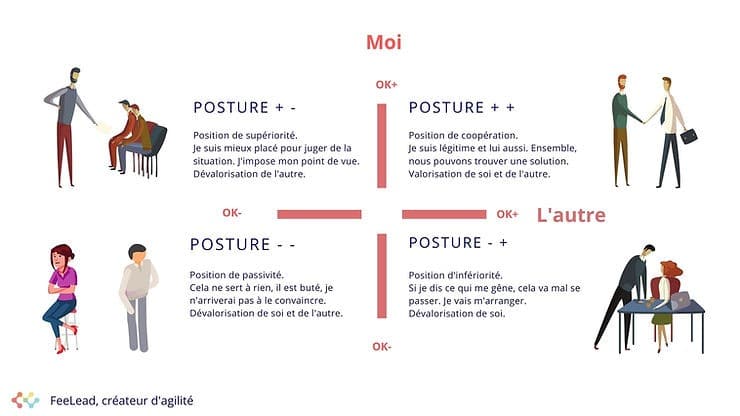If you're a project manager and a salesperson, you may have the impression of being torn between two incompatible objectives: developing a good relationship with your customers while being able to reframe them when necessary to protect the project, the teams, the company... and your own equilibrium. So it's vital to develop a win-win relationship. It's all a question of posture. So what is a win-win relationship? How do you go about it? Céline Aujames, PMP® Project Manager and NLP expert, suggests a few techniques to help you find the right posture to develop your customer relationships while keeping your projects under control.

Is the customer really king? When you're managing projects, you may feel that you have to give in to the customer all the time. If they change their mind, if they decide not to follow the procedures you've put in place, if they don't provide you with important information at the right time, if they act in bad faith... Not to mention the fact that sometimes the customer is even inside your company! A whole range of more or less pleasant emotions are on offer: from annoyance to frustration, not forgetting weariness, discouragement and anger...
In this context, the position of the salesperson is particularly delicate. They have to meet the customer's expectations, while at the same time securing the company's commercial objectives. So how do you find the right position?
[Training]
Manage customer relations as part of your projects
Develop customer-focused practices throughout the various phases of your project to preserve the framework of the relationship and establish a win-win relationship.
A win-win customer relationship: what is it really?
Transactional analysis has introduced a very enlightening concept, that of "life positions". This model postulates that only a win-win relationship - or (+/+) relationship - is constructive. It's based on mutual respect and meeting each other's needs. Any other type of relationship will be less effective in the long term.
L'transactional analysis is a theory created in 1958 by the Canadian psychoanalyst Eric Berne. It studies the relational exchanges between two or more people, known as "transactions".
Some examples of non-constructive situations involving a company and its customer
- The company submits to the customer's demands because it is the customer: " He's the one who pays, so let's do what he asks, even if it's inconvenient for us. "
- The company supplies the customer with a product that corresponds to the customer's expressed request, while being aware that this product will not correspond to the customer's real needs: "He doesn't know what he wants and in any case we don't know any better... "
- The company exploits the customer's weaknesses: "He didn't read the fine print in the contract, so too bad for him, and so much the better for us! "
At each moment, each of us positions ourselves positively or negatively in relation to others, depending on our perception of our respective values. So there are four combinations:
- we both have value (+/+)
- I have value and the other doesn't (+/-)
- I have no value and the other has (-/+)
- neither of us has any value (-/-)

To maintain a constructive relationship with your customers, the first step is to learn to recognise when the relationship is not balanced, so that you can adjust your position.
[Training]
Improving relationships through transactional analysis
Using the tools of transactional analysis, learn to know yourself better in your relationship with others, to establish positive relationships in interpersonal communication and to avoid conflict.
By the way, did you recognise the (-/+), (+/-), (-/-) relationship in the previous situations?
Solutions:
| Situation | Relationship |
|---|---|
| “ He's the one who pays, so let's do what he asks, even if it doesn't suit us. " | (-/+) The company loses, the customer wins |
| "He doesn't know what he wants, and in any case we don't know any better... " | (-/-) You're both losers |
| "He didn't read the fine print in the contract, so too bad for him, and so much the better for us! " | (+/-) The company wins, the customer loses |
Ask the right questions... and listen to the answers!
So how do you set up a win-win relationship? To do this, you need to answer a fundamental question: what do you each need to be a winner?
You have a responsibility to understand your customer's real needs. And to understand, you first have to listen. And really listening requires technique and practice.
L'active listening is the essential tool for establishing and maintaining a constructive relationship with your customer. The principles of active listening are both simple and subtle. They are extremely powerful in establishing a relationship of trust. Here are two fundamental keys to active listening.
[Training]
Develop your interpersonal effectiveness through active listening
Strengthen your interpersonal skills with active listening: learn to understand the people you are dealing with, create a climate of trust and communicate with empathy to improve collaboration and conflict resolution within your team.
Key No. 1: Unconditional acceptance
To be able to listen to another person, you must first accept them as a person. No judgement! The other person does not have the same vision as you, nor the same values, nor the same strategies, nor the same context. Their positions are just as valid as yours. If you don't bear this in mind when you talk to your customer, you won't be able to hear what they're saying.
Example
If your customer attaches great importance to quality of the products it markets and that for you it's the responsiveness You may find him too timid! When you talk to him, you may lack patience in the face of his hesitations, miss his concerns and rush him. It's important to accept that he sees things from a different angle to you.
Key No. 2: Questioning skills
To understand what the other person needs, you need to adopt a posture of total curiosity, and to do this you need to ask the most open questions possible. It's harder than it looks! To see for yourself, all you have to do is try out the "reverse yes-no" game with your colleagues. It consists of asking each other questions, but if a participant can answer "yes" or "no" to a question, they've won!
We're often conditioned to ask questions simply to validate our understanding, whereas the aim of active listening is to discover things we don't even know we have!
Examples
1/ Instead of asking: "Can you validate the schedule we have proposed?
Instead, ask: "What do you think of the schedule [...]? or "What do you want to adjust in the schedule [...] to validate it?
The aim is to detect possible customer reservations more effectively, so that they can be dealt with at source.
2/ Instead of asking: "Should we deal with problem A or problem B first?
Instead, ask: "What are your priorities?
The first approach locks the customer into your own perception of the situation, while the second leaves the customer free to express his or her reality, which could lead you to consider alternative, more relevant options (dealing partially with both problems, dealing with neither because there is another priority, paying extra to deal with both issues in parallel, etc.).
Don't forget your own needs: you can use these same two keys with yourself.
Clarifying and assuming your position: why and how?
La win-win posture is about respecting yourself while respecting others. It is therefore essential to getting to know yourself. It's by knowing what you want to embody that you'll be able to position yourself in a clear and stable way. Defining your professional stanceit's a bit like designate the suit you're going to wear: it must be in keeping with who you are and your vision of the world.
How to clarify your posture ? You can ask yourself the following questions: "What values do I bring to work?", "What is my vision of my job?", "What do I want to contribute through my work?
Defining your postural goals also means identify your challengesin other words qualities to be strengthened to balance your innate talents.
For example, you naturally have a great capacity for empathy with your customer. In this case, your challenge could be to learn to be firm. When faced with a customer requesting an unplanned feature, you will be able to show them that you understand their concerns about launching their product without this feature, while assertively reminding them that integrating this feature requires a formal change procedure to be set in motion.
Another example: if you like rigour and method and your customer tends to be disorganised, ask yourself how you can encourage them to be structured while developing your own flexibility!
Establishing a win-win situation means making the customer relationship a balanced and constructive partnership, in which each party has the opportunity to grow through contact with the other! You then involve your customer in the creation of an augmented reality, rich in both your visions.





